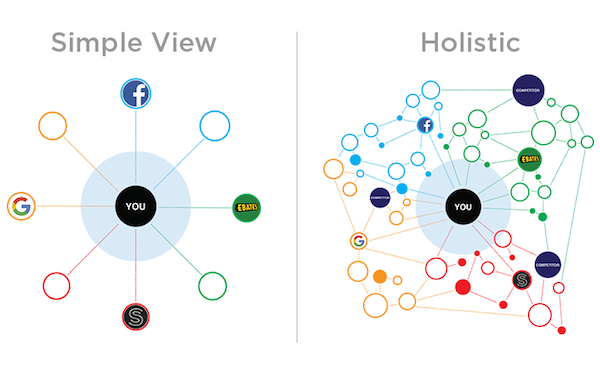I recently posted some preliminary ideas about semantic marketing, what the role of marketing could be in the semantic web. One of the most interesting notions that occurred to me is how the concept of brand will be extended in the semantic web. What will constitute semantic branding?
This intrigues me because on the surface “semantic branding” sounds like an oxymoron. What we popularly think of as brand seems much more suited to human experiences in the visual web than the standardized structuring of data in the semantic web that will underlie it.
But when you dig a little deeper into the meta-dynamics of branding and how they intersect with the goals of the semantic web, a powerful synergy emerges. One that could be a strategic battleground in the Web 3.0 era ahead.
To frame brand in the semantic web, I think it’s helpful to first step back and look at brand as a whole.
Brand is a funny thing. Amorphous and (mostly) intangible, yet at the same time specific and visceral. Brands shape and reflect our culture — objects to be studied in anthropology departments as much as in business schools. Coca-Cola isn’t just artificially flavored sugar water, it’s happiness in a bottle (and a multi-billion dollar empire).
That’s the grand, poetic view.
Down in the trenches, brand is built by thousands of tactics: names, logos, celebrity endorsements, slogans, jingles, product characteristics, customer experiences, distribution channels, product placements, movie merchandising, public relations, packaging, corporate philanthropy, viral YouTube videos, and just about every great television, radio, print, and (increasingly) web ad you can think of.
Almost every touchpoint between a company and the market contributes, intentionally or not, to its brand.
What does brand mean to the customer?
Brand as an image
The most common notion of brand is the imagery, association, and status conferred with owning or using a particular product or service. This is the source of our love/hate relationship with the power of brands, as it causes us to make seemingly irrational economic choices (why pay more for Dove soap than the generic equivalent?), warping price elasticity. In the extreme case of Veblen goods — where, as the price goes higher, people’s preference for buying actually increases — it outright inverts the price/demand curve. Nonetheless, brand of this kind has cultural, social, and emotional value that is demonstrably worth a premium to us.
Brand as a bookmark
Brand names are a quick, unequivocal way to identify something. If I find a particular variation of a product in a field of commodities (or near commodities) that I like, I can quickly find it again. I can tell other people about it without risk of confusion. If my wife tells me she likes Ben & Jerry’s Chunky Monkey ice cream, there’s no chance that I’m going to accidentally buy her some other brand of ice cream with stuff mixed in it. I don’t know if this “reference-ability” is worth much of a premium on its own, but it facilitates repeat purchases and referral business, which are immensely valuable, and enables all these other brand benefits.
Brand as a promise
Brand is also a promise to the customer, usually about quality and dependability. Who can tell one generic pain reliever from the next? But with Tylenol, you trust that the company has taken the utmost care in safety and reliability because their reputation depends on it — and their company depends on their reputation. In this way, brand is a commitment, a social contract of sorts, and it is perfectly logical for us to pay a premium for it.
Brand as a shortcut
Brand also gives us cues for making a good choice when we don’t have the time or inclination to research all the details that would be required for an exhaustive, purely analytical decision. I think of brand here as a decision shortcut: go with a brand you know from a related context or a brand that has been socially well-regarded in that space, and you know that you’re probably making a safe choice — even if it isn’t necessarily the optimal choice. This too is about trust, and as long as that trust is maintained, it’s worth a premium as well.
(Note that many of these interpretations of brand are also highly relevant in B2B marketing.)
So how does this translate to the semantic web?
Let’s summarize 5 of these meta-dynamics of brand and look for a pattern:
- Brand is about association, connecting one thing to another.
- Brand is about reference-ability, a (relatively) unique identifier.
- Brand is about consistency — reliable, predictable repeatability.
- Brand is about decision-helping, narrowing complicated choices quickly.
- Brand enables and encourages viral social propagation of itself.
Now substitute “brand” with “semantic web” in the list above. More than a few similarities? This parallelism between brand and the semantic web isn’t purely coincidental. Brand has engaged companies and products in a semantic web-like structure in our wetware, our psychology and social dynamics.
Flipped around, the semantic web will enable software to programmatically find and relate things in the Web in a way that mirrors how we as humans manually interact with the visual web (and to a certain degree, the world itself) — a highly branded experience.
Why is this parallel so interesting with specifically brand instead of with more abstract cognition in general? Because brand is the incarnation of such cognition as it best relates to commercialization. Brand isn’t just about association, recognition, consistency, etc. — it’s consciously focused on the capacity to monetize those assets.
The success of the semantic web — and of companies in the semantic web — depends on similar commercialization.
Given these parallels, I can envision three areas where branding and the semantic web can dovetail each other:
Area #1: Applying the concepts of branding — what has made brands successful or not successful — in the promotion and adoption of the semantic web itself. Recognizing the benefits of brand in the bullet list above gives us a business case for framing an organization’s participation in the semantic web movement.
Area #2: Employing a conscious brand strategy in an organization’s implementation of semantic technologies, content, and meta-data: the choice of specific categorizations, definitions, formats, network participation, etc. Where standards don’t yet exist, in domain-specific areas that are critical to your business, there is a phenomenal early adopter opportunity to help define such standards in a way that’s most beneficial. This is what I think of as pure “semantic branding”: how companies will define and protect their brands purely at the semantic layer. It’s interesting to think of the challenges that will arise here and how they are analogous to concepts such as brand rationalization, brand equity, and brand leveraging.
Area #3: Leveraging the benefits of the semantic web to enhance a company’s interactions with people in the visual web, thereby benefiting their brand in a more traditional sense. For example, if you’re a car company, leveraging semantic data to better connect your customers with after-market providers that can match on specific models and geographic constraints can improve your brand. You’re making the online services that surround your brand more useful, which in turn builds your brand. In this context, the semantic web is simply an enabler to a new generation of customer services.
Maybe semantic branding isn’t such an oxymoron after all.



